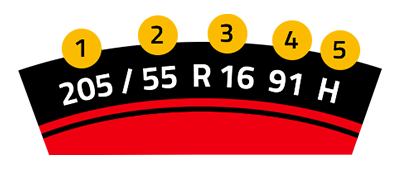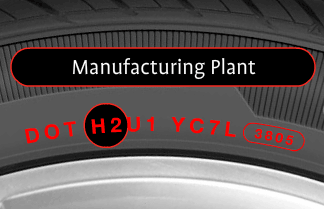- RATING & SELECTION
ALL-SEASON VS. TOURING VS. PERFORMANCE
All-Season tread designs will provide good all-around traction for varying road conditions such as wet, snow and ice, but still provide good tread wear and tire noise characteristics.
Performance tread designs have been engineered to enhance a vehicle`s handling capabilities on wet and dry roads, but usually exhibit increased tire noise and lack long tread wear life. Performance tread designs generally have larger tread elements to provide a stiff tread area for handling performance. Touring tread designs were designed to bridge the gap between all-season and performance tires. Touring tread designs combine the technology for good tread wear characteristics from all-season tires and handling and grip associated with performance tires. Touring tires also exhibit very good tire noise and ride comfort.
TREAD WEAR PERFORMANCE VS. GRIP/HANDLING/TRACTION PERFORMANCE ...
The tread wear/traction trade-off has been a focus in tire performance-enhancement technology for decades. Tire companies have been trying to reduce the trade-off between tread wear and traction through the development of new rubber compounds, new tread designs and new tire construction techniques. Basically, a tire will wear out quickly if it`s providing maximum grip to the road. This is due to the tread rubber being torn from the tire (on a microscopic level), while it adheres to the road surface. An excellent tread wear tire minimizes the amount of rubber being removed at the road surface, thus providing long tread life, but less road-gripping traction.
TIRE SPEED-RATING (S, T, H, V, W, Y, Z)
A common trade-off for higher speed-rating is reduced ride comfort. An S speed-rated tire will give a more comfortable ride compared to an H speed-rated tire - and an H speed-rated tire will give a more comfortable ride compared to a Z speed-rated tire. The ride comfort characteristics can be attributed to the tire`s overall stiffness. A tire capable of running at high speeds requires a more stiff construction in order to provide the necessary high speed stability and durability.
Tire Speed Ratings
Symbol Max Speed (mph & km/h) Symbol Max Speed (mph & km/h) Q 99 mph & 160 km/h R 106 mph & 170 km/h S 112 mph & 180 km/h T 118mph & 190 km/h U 124 mph & 200 km/h H 130 mph & 210 km/h V 149 mph & 240 km/h W 168 mph & 270 km/h Y 186 mph & 300 km/h (Y) Above 186 mph or Above 300 186 km/h Symbol Max Speed (mph & km/h) Q 186 mph & 300 km/h S 112 mph & 180 km/h U 124 mph & 200 km/h V 149 mph & 240 km/h Y 186 mph & 300 km/h R 106 mph & 170 km/h T 118mph & 190 km/h H 130 mph & 210 km/h W 168 mph & 270 km/h ZR Above 300 km/h or 186mph Z speed-rated tires originally reflected the highest tire speed rating - i.e., in excess of 149 mph. When new cars were developed that could exceed this speed, the automotive industry added the W and Y ratings. While a Z speed-rating still often appears, such as 215/50ZR16 91W, the Z in the size signifies a maximum speed capability in excess of 149 mph; the W in the service description indicates the tire`s 168 mph maximum speed. When the Y speed-rating in a service description is enclosed in parentheses, such as 285/35ZR19 (99Y), the top speed of the tire has been tested in excess of 186 mph, indicated by the service description as shown below:
Symbol Max Speed (mph & km/h) 285/35ZR19 99Y 186 mph & 300 km/h 285/35ZR19 (99Y) In excess of 186 mph or 300 km/h PRICE
As with the many different levels of tread design, tire performance and speed-ratings, there are many different levels of pricing within a category. For example, prices can vary from $50 per tire to $125 per tire depending on the brand name. When you multiply this price by four wheel positions, the price can become expensive and more difficult to justify.
HIGH PERFORMANCE TIRES
High Performance tires typically have speed-ratings of H or higher, although tire companies have developed entry-level performance tires that exhibit S and T speed-ratings for the people who want only the "look" of performance.
In order to maximize handling from a tire, high performance tire tread widths are wider than a typical all-season and touring tire. This allows maximum contact area with the road surface. In this case, wider is definitely better! The tread pattern incorporates larger tread blocks for increased stiffness. The tread compound is usually softer than a typical all-season and touring tire in order to provide more dry traction capability. Faster tread wear (less tread life) is generally observed in high performance tires because of the better dry traction capability. Racing tires are an extreme example of high performance tires, exhibiting maximum dry traction and grip, with significantly reduced tread wear life.
The stiffer construction used in high performance tires not only aids high-speed performance, but enhances tire handling characteristics. A high performance tire has quick steering response and plenty of available cornering power, which makes for excellent vehicle handling characteristics. Nylon reinforcement creates a stiffer belt package, which means better steering response and higher cornering grip. Usually, the carcass plies are angled or "biased" to increase the tire`s overall stiffness.




 korea
korea
 china
china
 japan
japan
 vietnam
vietnam
 australia
australia
 thailand
thailand
 germany
germany
 uk
uk
 spain
spain
 austria
austria
 russia
russia
 poland
poland
 france
france
 italy
italy
 usa
usa
 canada(eng)
canada(eng)
 brazil
brazil
 egypt
egypt

